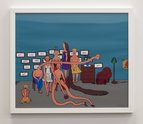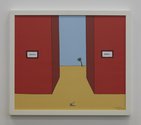John Hurrell – 22 April, 2017
Ekman's paintings can best be described as very funny, highly saturated coloured cartoons, rendered in a linear comic strip style. These single images have no sequential frames, but incorporate the raunchy female nudes of say Carroll Dunham, the elongated arms and rubbery necks of James Thurber, the surrealist domestic gender warfare of early Jim Nutt, and the acerbic observational detail of B. Kliban.
Auckland
Anoushka Akel, Halil Altindire. Billy Apple®, Marie-Louise Ekman, Hamishi Farah, Ayesha Green, Gil Hanly, David Hockney, Cengiz Tekin, Hito Steyerl, Matthew Ward for Miko Revereza
Biographies of Transition: Too Busy To Think
7 April - 12 May 2017
In this exhibition of a dozen artists, that ponders the constructive use of time to examine geographic, cultural, technological, corporeal and mental ‘cages’, there is one contributor that completely overshadows the rest - simply because so much of her work is there: the Swedish film-maker, university lecturer and painter, Marie-Louise Ekman.
I want to concentrate only on Ekman (b. 1944) as she presents ten framed paintings or screenprints under glass and - despite the pervasive and intrusive sound of the Halil Altindere / Abu Hajar hiphop video - they dominate the space. In June she will have a survey of 200 works in Moderna Museet in Stockholm, works produced from the sixties onwards, so the ten excellent works on paper here (ranging from between 1971 and 2001) can only whet our appetite and make us wish we could fly to Scandinavia.
Ekman’s paintings can best be described as very funny, highly saturated coloured cartoons, rendered in a linear comic strip style. These single images have no sequential frames, but incorporate the raunchy female nudes of say Carroll Dunham, the elongated arms and rubbery necks of James Thurber, the surrealist domestic gender warfare of early Jim Nutt, and the acerbic observational detail of B. Kliban. Over these are sprinkled copious references to the history of painting, such as the figures of Magritte, de Chirico and Botticelli.
Psychologically complicated, contradictory and conflicted, the works draw on Ekman herself as Exhausted Mother, Alarmed Newspaper Reader, Prostrate Murder Victim, Ultra-Horny Day Dreamer, Cosmic Satirist and Art Enthusiast - the leading character in a suite of entertaining, multi-layered, highly fanciful narratives. If you click on the two links here you will get a lot of visual information about her public persona in Sweden and her painting practice.
In Artspace, with the earlier 1971 paintings, the emphasis is more on written language as an essential element, as you might expect from that period. In On the Toilet we see the artist in a public convenience reading a newspaper where the densely positioned texts on the outer pages can be compared with the graffiti scratched on the cubicle walls.
In Good, there is a Magritte-like ambience where adjectives of positivity are scrutinised by a family of prospective users, all with extreme physiological disabilities, while in Mum Dad, the three family members are in the changing sheds, preparing to run out on to the solitary tropical beach. In which shed is the baby we wonder. Does the abandoned toy give us a clue? (There is also another interpretation, that the two parents are represented by two controlling walls between which the child must sprint to get to the beach, to experience the world free of overt mediation.)
With the two works made in 1973, one shows a prim lonely woman in her cold sitting room, fantasising about being on a warm beach in the diverting company of an attentive gentleman handy with his tongue. The other shows a woman murdered in a room lined with happy ‘cherry’ wallpaper. She has been shot in the neck but her faithful dog (with a disturbingly smug expression on his face) won’t move.
The three works from 1976 you could spend a lot of time looking at very closely. Sure the Botticelli based painting of the young Tintinesque girl on the seashell can probably be appreciated quite quickly, but with Love and In the Jungle there is much fine detail to be scrutinised. Looking at the two people kissing in Love there are a lot of opposing psychological messages revealed by little arms with weapons extending out from the ‘caressing’ fingertips. In In the Jungle we see an abandoned child with her toys being surrounded by group of circling hungry lions, all profusely farting various phantoms. There seems to be some metaphysical point Ekman is making here, about smelly (but ultimately evanescent) realities we pay far too much attention to.
One of the two later works from 1983 and 2001 shows a stampede of children’s toys fleeing out the door of a public gallery towards some bush, attempting to get away from the demands of visitors’ children. The last work references a very famous painting by de Chirico that by coincidence is currently on display in The (wonderful) Body Laid Bare show on at AAG. A walking breast emerges from under the receding viaduct on the left, about to strike up a conversation with what seems to be an abstract (Kenneth Noland?) painting standing in the shadow of a tower on the right. Maybe Ekman is chuckling about the type of (cerebral?) person she is sexually attracted to.
Presentations like this of Ekman’s work, and that of Shrigley currently in Christchurch, and the work of related artists like the late Tom Kreisler, remind us that there is a strong connection between thought and laughter. Venues like Artspace (and university galleries like St Paul St, and the Adam in Wellington) are perhaps prone to forgetting this - so this show is a refreshing and long overdue acknowledgement that intelligence is bodily, that a lot of thinking is not conscious, and that the results can be loud, raucous and mentally piercing.
John Hurrell

















 Advertising in this column
Advertising in this column Two Rooms presents a program of residencies and projects
Two Rooms presents a program of residencies and projects



This Discussion has 0 comments.
Comment
Participate
Register to Participate.
Sign in
Sign in to an existing account.